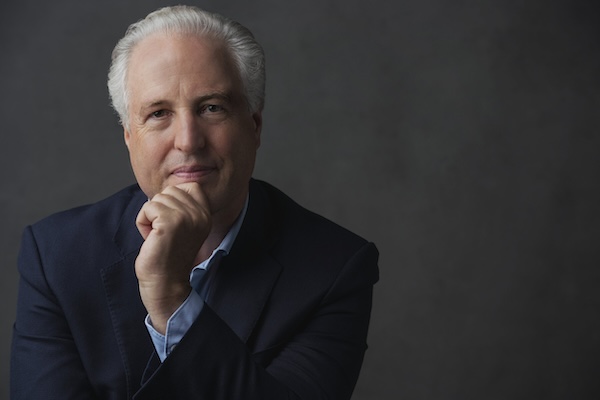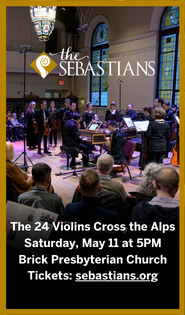Honeck and Rana bring fresh urgency to Russian favorites with Philharmonic

Rachmaninoff’s Piano Concerto No. 2 and Tchaikovsky’s Symphony No. 5 are undoubtedly warhorses of the repertoire. Yet with Manfred Honeck conducting the New York Philharmonic, however, they emerged remarkably fresh and thrilling on Friday evening.
It was a concert where melody, orchestral color, and emotion held sway, beginning with the first work on the program, the New York premiere of Katherine Balch’s musica pyralis (Music of the Firefly). The piece is co-commission by the Philharmonic and the Pittsburgh Symphony Orchestra, of which Honeck has been music director for 16 seasons.
Balch teaches composition at the Yale School of Music and is known for rooting her work in “lived experience” through creating a space to enjoy the sounds which surround us. With musica pyralis, Balch summons the mysteries and magic of a summer night at her home in rural Connecticut.
To recreate this atmosphere, Balch employed an ensemble heavy on woodwinds, brass and percussion, in addition to the usual complement of strings. The sounds of the natural world are depicted in the use of extended techniques including the harp tuned a quarter step down, woodwinds playing harmonics, and brass and flute players blowing wind through their instruments.
Honeck and the NY Phil created a summer night which seethed with excitement and even a touch of drama. The languorous mood was pierced by the buzz of insects, the rustle of leaves in the wind, and the brief appearance of a threatening nocturnal predator made real in masterful music brush strokes. The nocturnal cacophony was enriched with brief strokes of blissful melodies from the strings. Best of all, however, was the serenade of the bull frogs blatted out by the lower brass.
The sounds of a summer night were soon replaced by the intense melancholy of Rachmaninoff’s Piano Concerto No. 2 with Beatrice Rana as the soloist. Neither Rana nor Honeck are flashy performers, which made to focus solely on the concerto’s gorgeous melodies and succumb to the intense emotions which these fine artists generated with the lightest and deftest of touches.
Honeck led a performance which was defined by his subtle approach to dynamics and balance. This permitted Rana to do the same whether she was playing virtuosic solo passages or weaving her way through Rachmaninoff’s sinuous harmonies.
In the first movement, Rana played with a crystalline delicacy which was enchanting. When broad sweeps of melody were called for, she produced soaring waves of sound pulsing with emotion. She dispatched the beloved melodies and fiendishly tricky passages of the third movement with a subtle grandeur and astonishing ease.
The orchestra performed with the same level of sensitivity to detail. The surges of melodies from the strings bloomed rich and full. Solo passages were exceptionally heartfelt, especially the refined horn playing in the first movement and the beautiful exchange between flute and piano in the second. The final movement throbbed with all the passion for which one could hope.
For an encore, Rana performed Chopin’s Etude No. 13 in A-flat major, Op. 25, no. 1. Her captivating performance illuminated this more intimate work with the same detail, beauty, and emotion which she had displayed on a much grander scale in the Rachmaninoff.
Stately best summed up Honeck’s approach to Tchaikovsky’s Fifth Symphony. It also served to impose structure on a work which even the composer acknowledged wasn’t a paradigm of form. As in the Rachmaninoff, Honeck’s attention to scale and dynamics resulted in a richly rewarding experience, both musically and emotionally.
Honeck began the first movement very softly, which generated a sense of anticipation more than foreboding, the emotion generally associated with the piece. The waltz-like music glistened, while the woodwinds exhibited the personality and wit which prevailed in their playing throughout the performance.
In the second movement, the playing of Stefán Jón Bernharðsson, guest principal horn, was simply stunning. His interplay with principal clarinetist Anthony McGill was as notable for the depth of feeling they generated, as for the beauty their respective music making.
Delicacy and transparency combined to give the Waltz an ethereal beauty. Individual solos gave way to a sheen of glistening orchestral sound guided gracefully by Honeck’s innate sense of style and sensitivity. From the warm waves of string sound which began the finale to the great slashes of brass chords, Honeck guided the orchestra in a measured release of intensity and force which culminated in a duly triumphant coda.
The program will be repeated 8 p.m. Saturday and 2 p.m. Sunday. nyphil.org








